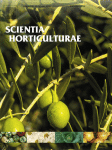Ver ítem
- xmlui.general.dspace_homeCentros Regionales y EEAsCentro Regional Buenos Aires NorteEEA San PedroArtículos científicosxmlui.ArtifactBrowser.ItemViewer.trail
- Inicio
- Centros Regionales y EEAs
- Centro Regional Buenos Aires Norte
- EEA San Pedro
- Artículos científicos
- Ver ítem
Estimation of sample size in skin and flesh color measurements of dry flesh sweetpotato (Ipomoea batatas (L) Lam.)
Resumen
Nineteen entries (cultivars and breeding lines) selected to represent the range of purple skin, dry flesh sweetpotatoes most probably found by researchers were used to relate previous sweetpotato color descriptions to objective color measurements, and determine the optimum sample procedure to detect differences in color variables of skin and flesh. The results of this experiment suggest that visual evaluation can differentiate a range in skin color made
[ver mas...]
Nineteen entries (cultivars and breeding lines) selected to represent the range of purple skin, dry flesh sweetpotatoes most probably found by researchers were used to relate previous sweetpotato color descriptions to objective color measurements, and determine the optimum sample procedure to detect differences in color variables of skin and flesh. The results of this experiment suggest that visual evaluation can differentiate a range in skin color made with a chromameter using three readings in each of three roots for color intensity (Chroma C), but it would be necessary to sample more than five roots and three readings per root for hue (h°).
More roots and readings per root were needed to detect desired differences for lightness, intensity, and hue in the skin than in the flesh. To detect a significant difference in skin color, it would be necessary to test many more roots and/or readings per root, than for a similar difference of flesh color. For example, skin lightness, intensity, and hue would require at least 9, 15, and 15 root readings to detect a difference equal to 15% of the visual range, where only 2, 5, and 1 reading of flesh values would be necessary, respectively, to detect the same magnitude in difference.
[Cerrar]

Autor
Fuente
Scientia Horticulturae 98 (4) : 331-336 (Sept. 2003)
Fecha
2003
Editorial
Elsevier
ISSN
0304-4238
Formato
pdf
Tipo de documento
artículo
Palabras Claves
Derechos de acceso
Restringido
 Excepto donde se diga explicitamente, este item se publica bajo la siguiente descripción: Creative Commons Attribution-NonCommercial-ShareAlike 2.5 Unported (CC BY-NC-SA 2.5)
Excepto donde se diga explicitamente, este item se publica bajo la siguiente descripción: Creative Commons Attribution-NonCommercial-ShareAlike 2.5 Unported (CC BY-NC-SA 2.5)

